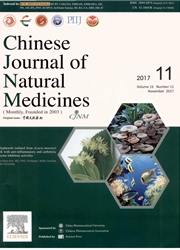

 中文摘要:
中文摘要:
AIM: To reveal the profile of astragalosides for better quality evaluation of Radix Astragali, this study was aimed to investigate the transformation of astragalosides under different conditions. METHOD: Seven major astragalosides were selected for evaluation under acidic, neutral and alkaline conditions. The transformation in real plant samples was also examined and the products were characterized by LC-ESI-TOF/MS. RESULTS: In weak acidic solution, all of the astragalosides are stable. In addition, the transformation ratios of the astragalosides under neutral and alkaline conditions were also obtained. CONCLUSION: In neutral solution, malonylastragaloside I was transformed to astragaloside I; and in alkaline solution, substituent group(s) in the xylose moiety of all the astragalosides were eliminated. Since astragalosdie IV is the basic skeleton structure of the astrgalosides, it is a common transformation product of other astragalosides.
 英文摘要:
英文摘要:
AIM: To reveal the profile of astragalosides for better quality evaluation of Radix Astragali, this study was aimed to investigate the transformation of astragalosides under different conditions. METHOD: Seven major astragalosides were selected for evaluation under acidic, neutral and alkaline conditions. The transforma- tion in real plant samples was also examined and the products were characterized by LC-ESI-TOF/MS. RESULTS: In weak acidic solution, all of the astragalosides are stable. In addition, the transformation ratios of the astragalosides under neutral and alkaline conditions were also obtained. CONCLUSION: In neutral solution, malonylastragaloside I was transformed to astragaloside I; and in alkaline solution, substitu- ent group(s) in the xylose moiety of all the astragalosides were eliminated. Since astragalosdie IV is the basic skeleton structure of the astrgalosides, it is a common transformation product of other astragalosides.
 同期刊论文项目
同期刊论文项目
 同项目期刊论文
同项目期刊论文
 Suppressionofexperimentalabdominalaorticaneurysms in themicebytreatmentwith Ginkgo biloba extract(EG
Suppressionofexperimentalabdominalaorticaneurysms in themicebytreatmentwith Ginkgo biloba extract(EG Suppression of experimental abdominal aortic aneurysms in the mice by treatment with Ginkgo biloba e
Suppression of experimental abdominal aortic aneurysms in the mice by treatment with Ginkgo biloba e Integrated evaluation of malonyl ginsenosides, amino acids and polysaccharides in fresh and processe
Integrated evaluation of malonyl ginsenosides, amino acids and polysaccharides in fresh and processe Rapid preparation of rare ginsenosides by acid transformation and their structure-activity relations
Rapid preparation of rare ginsenosides by acid transformation and their structure-activity relations Transformation of astragalosides from Radix Astragali under acidic, neutral, and alkaline extraction
Transformation of astragalosides from Radix Astragali under acidic, neutral, and alkaline extraction A standardized notoginseng extract exerts cardioprotection by attenuating apoptosis under endoplasmi
A standardized notoginseng extract exerts cardioprotection by attenuating apoptosis under endoplasmi Environmentally friendly ionic liquid-in-water microemulsions for extraction of hydrophilic and lipo
Environmentally friendly ionic liquid-in-water microemulsions for extraction of hydrophilic and lipo 期刊信息
期刊信息
